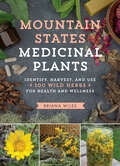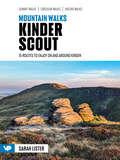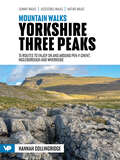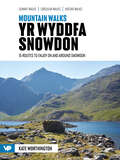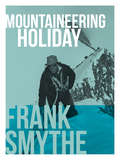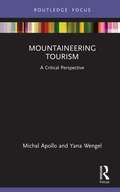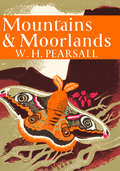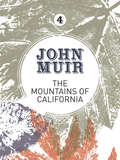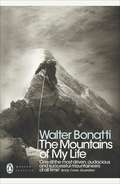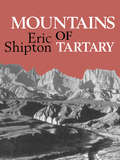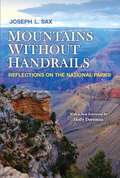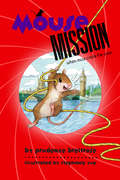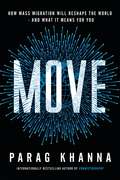- Table View
- List View
Mountain States Foraging: 115 Wild and Flavorful Edibles from Alpine Sorrel to Wild Hops (Regional Foraging Series)
by Briana WilesMountain States Foraging is part of the Timber Press Regional Foraging book series. Perfect for new and experiences foragers in Colorado, eastern Oregon, eastern Washington, Idaho, Montana, Nevada, Wyoming, southernmost Alberta, and southernmost Saskatchewan.
Mountain States Medicinal Plants: Identify, Harvest, and Use 100 Wild Herbs for Health and Wellness
by Briana WilesForagers and herbalists in the Mountain States will adore this indispensable guide to finding, identifying, and using the medicinal plants that grow wild, local, and natural.
Mountain Timberlines: Ecology, Patchiness, and Dynamics (Advances in Global Change Research #36)
by Friedrich-Karl HoltmeierFor more than 40 years I have been engaged in timberline research. Thus, one could suppose that writing this book should not have been too difficult. It was harder, however, than expected, and in the end I felt that more questions had arisen than could be answered within its pages. Perhaps it would have been easier to write the book 30 years ago and then leave the subject to mature. Lastly it was the late Prof. Heinz Ellenberg who had convinced me to portray a much needed and complete picture of what we know of the timberline with special respect to its great physiognomic, structural and ecological variety. The first version of this book was p- lished in the German language (Holtmeier, 2000). Nevertheless, I was very delighted when Prof. Martin Beniston encouraged me to prepare an English edition for the series ‘Advances in Global Change Research’, which guaranteed a wider circulation. Timberline is a worldwide and very heterogeneous phenomenon, which can only be presented by way of examples. My own field experience is necessarily limited to certain timberline areas, such as the Alps, northern Scandinavia, northern Finland and many high mountain ranges in the western United States and Canada. However, my own observations and the results of my and my previous collaborators research were essential for developing the concept of the book and became integrated into the picture of timberline that is presented in the following chapters.
Mountain Walks Kinder Scout: 15 routes to enjoy on and around Kinder (Mountain Walks)
by Sarah ListerMountain Walks Kinder Scout by Sarah Lister is a guide to walking routes up and around Kinder Scout in the Peak District. Alongside the routes up to the plateau, there are also valley walks for mixed weather days and those new to mountain walking. Among the 15 inspiring routes, the classics are all included, such as Grindsbrook Clough from Edale, and Kinder Downfall from Hayfield, and even those who are familiar with the area will find new and imaginative route ideas to discover. Whether you aspire to walk up Kinder on a straightforward route, or you're looking for a bigger adventure, this is the only guidebook you need. Together with stunning photography, each route features: Ordnance Survey 1:25,000 maps; easy-to-follow, detailed directions; essential info about public transport and safety advice; details about the terrain and navigation; facilities, refreshments and points of interest; and downloadable GPX files.
Mountain Walks Yorkshire Three Peaks: Walking routes to enjoy on and around Pen-y-ghent, Ingleborough and Whernside (Mountain Walks)
by Hannah CollingridgeMountain Walks Yorkshire Three Peaks by Hannah Collingridge is a guide to walking routes on and around Pen-y-ghent, Ingleborough and Whernside in the Yorkshire Dales National Park. Alongside the routes to the peaks themselves, there are also valley walks for mixed-weather days and those new to hillwalking. The routes explore the local area, visiting local caves and beauty spots and showcasing the stunning limestone scenery; even those who are familiar with the area will find new and imaginative route ideas to discover. Whether you aspire to walk in the southern Dales on a straightforward route, or you're looking to take on the full Three Peaks challenge, this is the only guidebook you need. Together with stunning photography, each route features Ordnance Survey 1:25,000 maps; easy-to-follow, detailed directions; downloadable GPX files; essential information about public transport and safety advice; details about the terrain and navigation; and information about facilities, refreshments and points of interest.
Mountain Walks Yr Wyddfa/Snowdon: 15 routes to enjoy on and around Snowdon (Mountain Walks)
by Kate WorthingtonMountain Walks Yr Wyddfa/Snowdon by Kate Worthington is a guide to walking routes to the summit of Yr Wyddfa in Eryri (Snowdonia). Alongside the summit routes, there are also lower-level alternatives for mixed weather or shorter days and those new to mountain walking. Among the 15 inspiring routes, the classics are all included, such as the Yr Wyddfa/Snowdon Horseshoe via the grade-1 scramble of Crib Goch, and even those who are familiar with the area will find new and imaginative route ideas to discover. Whether you aspire to climb Yr Wyddfa on a straightforward route, or you're looking for a bigger adventure, this is the only guidebook you need. Together with stunning photography, each route features: Ordnance Survey 1:25,000 maps; easy-to-follow, detailed directions; essential info about public transport and safety advice; details about the terrain and navigation; facilities, refreshments and points of interest; and downloadable GPX files.
Mountaineering Holiday: An Outstanding Alpine Climbing Season, 1939
by Frank SmytheThere is no holiday like a mountaineering holiday. For eleven months the mountaineer has sighed for the mountain wind on his cheek, for the lilt of the mountain stream, for the feel of rock in his hand, for the crunch of frozen snow beneath his feet, for the smell of mist and the fragrance of alp and pine forest. 'In his spare moments he has read about mountains, pored over maps, and studied guidebooks. Then comes the day when he inspects his boots, his ice axe, and his rope. He packs his rucksack. He buys his railway ticket. The incredible has become credible. For two weeks, three weeks, or a month he will escape from civilisation and all its works; he is off to the mountains.' In Mountaineering Holiday, Frank Smythe records 'an outstanding Alpine climbing season' - his 1939 summer holiday Writing in his typically engaging style of keen observation, entertaining anecdote and remarkable knack for description, Smythe takes the reader with him on his trip into the Alps. Arriving unfit and out of practice, he gets stuck behind slower climbers and spends rainy days confined to the valleys before making an impressive number of successful ascents and historic climbs: Mont Tondu, the Aiguille de Bionnassay, the Brenva Face - and an ascent of the Innominata Ridge of Mont Blanc. There is a wonderful sense of familiarity about the book. Smythes's experiences and emotions are instantly recognisable by the modern climber, evoking memories of other trips and mountain days. And his examination of our need for mountains and wild places reaches conclusions that strike a chord with everybody who enjoys the great outdoors. Yet this is the 1930s. Mountaineering equipment and technique are in their infancy. Attitudes within climbing are markedly different to those of today and the first ascents of many major routes are still to be claimed. Europe is on the brink of war and fearful of the future. The book's final climb is made with four young Germans - mere days before World War II …
Mountaineering in Scotland: The first of W.H. Murray's great classics of mountain literature
by W.H. MurrayIn Mountaineering in Scotland, climber and mountaineer W.H. Murray vividly describes some of the most sought-after and classic British climbs on rock and ice, including the Cuillin Ridge on Skye and Ben Nevis.The book – written in secret on toilet paper in whilst Murray was a prisoner of war – is infused with the sense of freedom and joy the author found in the mountains. He details the hardship and pleasure wrung from high camping in winter, climbs Clachaig Gully and makes the second winter ascent of Observatory Ridge. Murray recounts his adventures in Glencoe and the mountains beyond – including a terrifying near-death experience at the falls of Falloch.Murray’s first book, Mountaineering in Scotland is widely acknowledged as a classic of mountaineering literature. It inspirational prose – as fresh now as when first published – is bound to make a reader reach for their tent and head for the hills of Scotland. He asserts, ‘Seeming danger ensures that on mountains, more than elsewhere, life may be lived at the full.’This is classic mountain climbing literature at its best.
Mountaineering Tourism: A Critical Perspective (Routledge Focus on Tourism and Hospitality)
by Michal Apollo Yana WengelThis book offers a critical account of the historical evolution of mountaineering and its relation to the phenomenon of tourism, providing an overview of recent developments linked to the diversification, commodification and commercialisation of mountaineering activity. Mountaineering, broadly defined as hiking, trekking and climbing, is now a mass phenomenon, with continually growing numbers of trekkers, climbers and religious tourists hiking in mountain regions. Increasing visitor numbers require the current policies to be updated. The environments around high-mountain areas and their local resident communities, until recently cut off from civilisation, are sensitive to outside influences and have been abruptly exposed to the impact of mountaineering and related activities. This is the first book to disentangle overlapping terms and definitions related to mountaineering tourism. It identifies the key terms and turning points in mountaineering tourism and discusses the impacts of mountaineering tourism from an environmental, socio-cultural and personal perspective and identifies current tourism management policies. Finally, this book provides a continuum between the past and future of mountaineering tourism and aims to provide policy suggestions for sustainable management of fragile mountain regions. This will be of great interest to upper-level students and academics of tourism, as well as industry representatives and policymakers with an interest in adventure tourism and mountaineering.
Mountaineering Tourism: A Critical Perspective (Routledge Focus on Tourism and Hospitality)
by Michal Apollo Yana WengelThis book offers a critical account of the historical evolution of mountaineering and its relation to the phenomenon of tourism, providing an overview of recent developments linked to the diversification, commodification and commercialisation of mountaineering activity. Mountaineering, broadly defined as hiking, trekking and climbing, is now a mass phenomenon, with continually growing numbers of trekkers, climbers and religious tourists hiking in mountain regions. Increasing visitor numbers require the current policies to be updated. The environments around high-mountain areas and their local resident communities, until recently cut off from civilisation, are sensitive to outside influences and have been abruptly exposed to the impact of mountaineering and related activities. This is the first book to disentangle overlapping terms and definitions related to mountaineering tourism. It identifies the key terms and turning points in mountaineering tourism and discusses the impacts of mountaineering tourism from an environmental, socio-cultural and personal perspective and identifies current tourism management policies. Finally, this book provides a continuum between the past and future of mountaineering tourism and aims to provide policy suggestions for sustainable management of fragile mountain regions. This will be of great interest to upper-level students and academics of tourism, as well as industry representatives and policymakers with an interest in adventure tourism and mountaineering.
Mountains: Environmental Issues, Global Perspectives
by James Fargo BalliettAlways awe-inspiring, mountainous areas contain hundreds of millions of years of history, stretching back to the earliest continental landforms. This book shows how mountains are characterized by their distinctive geological, ecological, and biological conditions. Often, they are so large that they create their own weather patterns. They also store nearly one-third of the world’s freshwater—in the form of ice and snow—on their slopes. Despite their daunting size and often formidable climates, mountains are affected by growing local populations, as well as distant influences, such as air pollution and global climate change. Three detailed case studies are presented. The first shows how global warming in East Africa is harming Mount Kenya’s regional population, which relies on mountain runoff to irrigate farms for subsistence crops. The second examines the fragile ecology of the South Island Mountain in New Zealand’s Southern Alps and how development threatens the region’s endemic plant and animal species. The third discusses the impact of mountain use over time in New Hampshire’s White Mountains, where management efforts have been used to limit the growing footprint of millions of annual visitors and alpine trekkers.
Mountains: Environmental Issues, Global Perspectives
by James Fargo BalliettAlways awe-inspiring, mountainous areas contain hundreds of millions of years of history, stretching back to the earliest continental landforms. This book shows how mountains are characterized by their distinctive geological, ecological, and biological conditions. Often, they are so large that they create their own weather patterns. They also store nearly one-third of the world’s freshwater—in the form of ice and snow—on their slopes. Despite their daunting size and often formidable climates, mountains are affected by growing local populations, as well as distant influences, such as air pollution and global climate change. Three detailed case studies are presented. The first shows how global warming in East Africa is harming Mount Kenya’s regional population, which relies on mountain runoff to irrigate farms for subsistence crops. The second examines the fragile ecology of the South Island Mountain in New Zealand’s Southern Alps and how development threatens the region’s endemic plant and animal species. The third discusses the impact of mountain use over time in New Hampshire’s White Mountains, where management efforts have been used to limit the growing footprint of millions of annual visitors and alpine trekkers.
Mountains: Mountains Library Ebook (Geographywise #4)
by Jen GreenThe aim of this series is to encourage children to explore the wonders of the physical world around them - the geographical features that make our planet unique and amazing - and understand how humans use it. Towering mountains, gushing rivers, windswept deserts and jagged coastlines... each title will first look at the agents of change that form these landforms and then go on to explore the different types of environments in which they can be found, how they are used by humans, from dams to skiing resorts and how they can be conserved. Maps will show where features are found in the world and diagrams will explain formations and processes, such as how a river erodes its valley as it flows down to its mouth, a how block mountain is formed, how waves crashing the shore produce headlands and bays, and how wind scours caves in deserts.
Mountains: Mountains Library Ebook (Popcorn: Geography Corner)
by Ruth ThomsonExplore the distant corners of the world! Find out about the world's active volcanoes, read all about the world's most spectacular mountains and see how people live in the mountains. Discover mountain animals, farmers and transport and learn how to make a model volcano.
Mountains and Moorlands (Collins New Naturalist Library #11)
by W. H. PearsallAn invaluable introduction to the upland regions of Britain – their structure, climate, vegetation and animal life, their present and past uses and the problems of their conservation for the future. This edition is exclusive to newnaturalists.com
The Mountains of California (Large Print Ser.)
by John MuirA great hero of America's conservation movement, John Muir (1838–1914) was active in establishing the Yosemite Valley as a protected national park and in awakening interest in the importance of safeguarding natural resources. In this tribute to the grandeur of the Sierras, Muir recounts his journeys by foot through the Yosemite Valley, Mount Whitney, the famed sequoia forests, King's Canyon, and other wilderness areas. With a natural historian's keen eye for flora, geography, and geology, Muir describes glaciers, lakes, trees, and the daily lives of the region's inhabitants. His lyrical narrative, imbued with the deepest understanding and respect for nature, examines the ways in which natural forces shape the landscape and the effects of the changing seasons. The zesty travelogue is accompanied by splendid illustrations of maps, plants, and animals. Originally published in 1894, The Mountains of California continues to delight and inform readers.
The Mountains of California: An enthusiastic nature diary from the founder of national parks (John Muir: The Eight Wilderness-Discovery Books)
by John Muir‘How glorious a greeting the sun gives the mountains! To behold this alone is worth the pains of any excursion a thousand times over.’John Muir is known internationally for his dedication to protecting the environment and for founding The Sierra Club in 1892. His first book, as Muir authority Terry Gifford writes in the foreword, ‘became the bible of the fledgling Sierra Club, which is now a major national environmental activists’ organisation with branches in every corner of America’.The Mountains of California not only details Muir’s visits to the magnificent mountains along the Sierra Nevada Range, which he affectionately calls ‘The Range of Light’, but also the stunning glaciers, forests and landscapes that he encounters: ‘Climbing higher, I saw for the first time the gradual dwarfing of the pines in compliance with climate … patches of the dwarf vaccinium with its round flowers sprinkled in the grass like purple hail; while in every direction the landscape stretched sublimely away in fresh wildness: a manuscript written by the hand of nature alone.’Throughout the book, Muir’s philosophy of nature’s ability to soothe and amaze is evident. He heart-warmingly discusses at length how his encounters with animals, such as the Douglas squirrel, cheered him so. This is a truly beautiful read; Muir’s writing, embedded with emotion, wit, and at times, humour, will never fail to speak to his reader.The enthusiasm contained within these pages is infectious, and as well as making a powerful read, Muir will inspire you, too, to ‘come and see’ the innumerable delights that nature can offer:‘The best words only hint at [California’s] charms. Come to the mountains and see.’
The Mountains of My Life (Penguin Modern Classics)
by Robert Marshall Walter BonattiThe Mountains of My Life collects Walter Bonatti's classic writings detailing his exploits on numerous expeditions to different mountains of the world, as well as the real story behind the controversy over the events on K2 that changed his life. Bonatti is one of the greatest mountaineers of all time, and these awe-inspiring writings capture the adventure, audacity and magnitude of his craft.
Mountains of Tartary: Mountaineering and exploration in northern and central Asia in the 1950s
by Eric ShiptonIn Undiscovered Scotland climbing and mountaineer W.H. Murray transports the reader to the wilds of Scotland, exploring the hills and climbing on ice, rock and snow. Murray, a former prisoner of war, is relishing his freedom – all the sweeter following his captivity – and we follow him on his adventures in Scotland to the Isle of Rum, Skye, Glencoe and the Cuillin as he enjoys the fellowship, struggles, pleasures and beauty which mountain climbing bestows upon him. Here are the joys of the high mountains, the sun glinting on burn pools, and the peace of wilderness evenings. Undiscovered Scotland is Murray’s second book. Like his first, Mountaineering in Scotland, it is hailed as one of the great classics of mountain literature; poetic and inspirational for any keen climber, walker or mountaineer, even the armchair kind. ‘The touch of wind on the cheek, rocks, the smell of pines and bog-myrtle, morning dew and the song of water, snow-ridges in sun, tall trees and corries. Let us see their beauty and remember … ’
Mountains Without Handrails: Reflections on the National Parks
by Joseph L. SaxBeloved by academic and general readers alike, Mountains Without Handrails, Joseph L. Sax’s thought-provoking treatise on America’s national parks, remains as relevant today as when first published in 1980. Focusing on the long-standing and bitter battles over recreational use of our parklands, Sax proposes a novel scheme for the protection and management of America's national parks. Drawing upon still controversial disputes—Yosemite National Park, the Colorado River in the Grand Canyon, and the Disney plan for California's Mineral King Valley—Sax boldly unites the rich and diverse tradition of nature writing into a coherent thesis that speaks directly to the dilemma of the parks. In a new foreword, environmental law scholar Holly Doremus articulates this book’s enduring importance and reflects on what Sax, her former teacher, might have thought about the encroachment of technology into natural spaces, the impact of social media, and growing threats from climate change. At this moment of great uncertainty for the national parks, Mountains Without Handrails should be read (and re-read) by anyone with a stake in America’s natural spaces.
The Mourne and Cooley Mountains: A Walking Guide
by Adrian HendroffThe Mourne and Cooley Mountains are quite simply a hiker’s paradise. The highest and most dramatic mountain range in Northern Ireland, the Mournes hug the County Down coastline in a compact region designated as an Area of Outstanding Natural Beauty. The Cooley Peninsula – a finger of land in County Louth bounded in the north by the spectacular Carlingford Lough – is one of Ireland’s best kept secrets. These exhilarating walks will take you to the highest point in Northern Ireland. Trek through the picturesque woodland trails of Castlewellan and Tollymore. Discover the highest passage tomb in Ireland. Walk along an old smuggler’s route, tranquil reservoirs and the sand-dunes of Murlough Nature Reserve. The more ambitious will relish the Mourne Wall challenge, and some summits include optional scrambles to the top of dramatic granite tors or rocky outcrops. Each graded route is illustrated with photographs and specially drawn maps. Snippets on the rich flora, fauna, geology, history, heritage and folklore of each area are included throughout. So, get your walking boots on and discover the impressive landscape that spawned the legend of the Táin Bó Cúailnge and inspired C. S. Lewis’ magical world of Narnia.
Mouse Mission (A\mousenet Book Ser.)
by Prudence BreitroseIt's An Undercover Adventure! When a remote island's rain forest is threatened by the greedy timber com pany Loggocorp, the Humans Who Know (that mice have evolved) develop a secret plan to save the forest. And they need all the help they can get from the Big Cheese, Trey, and their other friends in the Mouse Nation. First, the team must unravel a centuries-old mystery: Who actually owns the rain forest? The mission to find that person brings Megan and her family across the ocean to England, where everything starts to go just a little bit . . . weird. Loggocorp spies are watching the family's every move as they, too, search for the rightful owner of the island's natural treasure. It's a race against the clock to save the rain forest! The trail leads to a duke's palace full of strange guests and a clan of helpful British mice. And Megan, the most famous human in the world (among mice), has to face her biggest challenge yet.
Move: How Mass Migration Will Reshape the World – and What It Means for You
by Parag KhannaWhere will you live in 2030? Where will your children settle in 2040? What will the map of humanity look like in 2050?In the 60,000 years since people began colonising the continents, a recurring feature of human civilisation has been mobility - the constant search for resources and stability. Seismic global events - wars and genocides, revolutions and pandemics - have only accelerated the process. The map of humanity isn't settled, not now, not ever.As climate change tips toward full-blown crisis, economies collapse, governments destabilise and technology disrupts, we're entering a new age of mass migrations - one that will scatter both the dispossessed and the well-off. Which areas will people abandon and where will they resettle? Which countries will accept or reject them? As today's world population, which includes four billion restless youth, votes with their feet, what map of human geography will emerge?Here global strategy advisor Parag Khanna provides an illuminating and authoritative vision of the next phase of human civilisation - one that is both mobile and sustainable. As the book explores, in the years ahead people will move to where the resources are and technologies will flow to the people who need them, returning us to our nomadic roots while building more secure habitats. Move is a fascinating look at the deep trends that are shaping the most likely scenarios for the future. Most importantly, it guides each of us as we determine our optimal location on humanity's ever-changing map.
Movement Ecology of Neotropical Forest Mammals: Focus on Social Animals
by Rafael Reyna-Hurtado Colin A. ChapmanThis book brings a unique perspective to animal movement studies because all cases came from tropical environments where the great diversity, either biological and structurally (trees, shrubs, vines, epiphytes), presents the animal with several options to fulfill its live requirements. These conditions have forced the evolution of unique movement patterns and ecological strategies. Movement is an essential process in the life of all organisms. Animals move because they are hungry, thirsty, to avoid being eaten, or because they want to find mates. Understanding the causes and consequences of animal movement is not an easy task for behavioural ecologists. Many animals are shy, move in secretive ways and are very sensible to human presence, therefore, studying the movements of mammals in tropical environments present logistical and methodological challenges that have recently started to be solved by ecologist around the world. In this book we are compiling a set of extraordinary cases where researchers have used some of the modern technology and the strongest methodological approaches to understand movement patterns in wild tropical mammals. We hope this book will inspire and encourage young researchers to investigate wild mammal´s movements in some of the amazing tropical environments of the world.
Moving Beyond Environmental Compliance: A Handbook for Integrating Pollution Prevention with ISO 14000
by Thomas Elliott WelchSince the U.S. Department of Energy (as well as other Federal and International agencies) will stop granting contracts to companies that fail to comply with 14000 standards, the search is on for any book that will make 14000 compliance easier. Tom Welch, with more than 20 years experience in environmental engineering and project management, provides such a book! Moving Beyond Environmental Compliance: A Handbook for Integrating Pollution Prevention with ISO 14000 is the first text to combine the best aspects of Pollution Prevention (P2), Total Quality Management (TQM), and ISO 14000, into a comprehensive "how-to" guidebook for achieving environmental compliance.The ever-increasing cost of environmental compliance as it is passed onto consumers, cuts into the profit margin and reduces an organization's competitive edge. At the very least, compliance cuts into operating budgets, and directs attention away from the primary business of an organization. This handbook demystifies the implementation of effective environmental management systems as described in the ISO 14000, and clarifies the application of effective pollution prevention methodologies that can drastically reduce this compliance burden.

